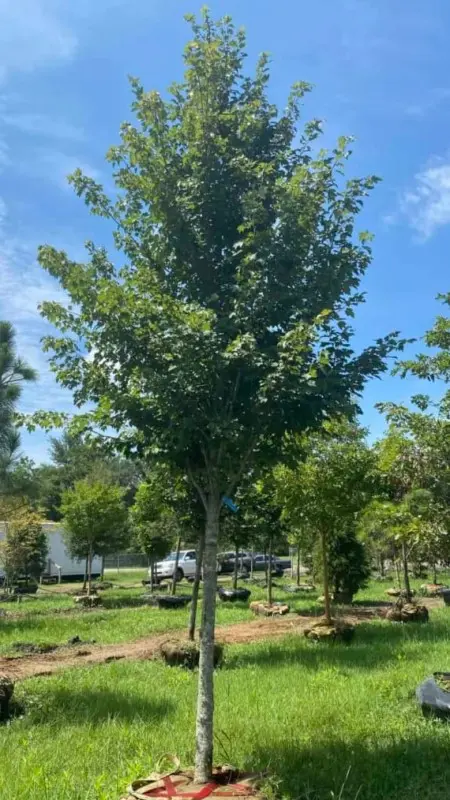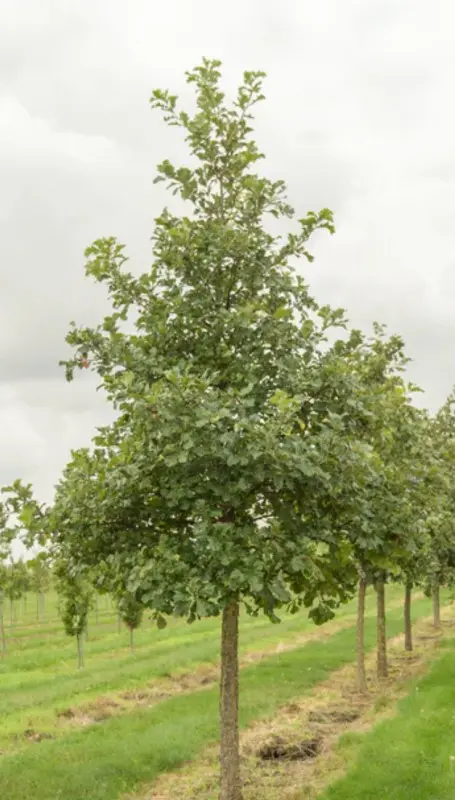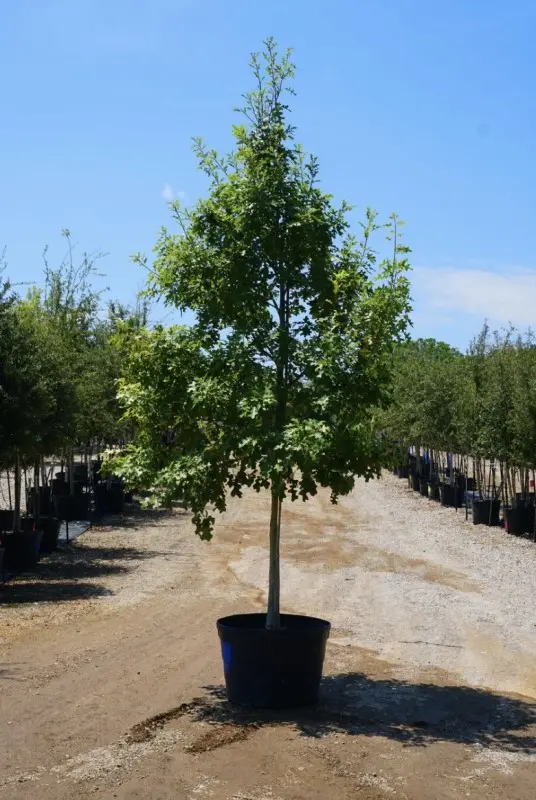-

American Sycamore
$0.00
Deciduous (loose leaves in winter)
Up to 70'
Grows up to 24" per year
-
American Sycamore (Platanus occidentalis), also known as American Planetree or Eastern Sycamore, is a large, deciduous tree celebrated for its distinctive, peeling bark and broad, maple-like leaves. Native to the eastern United States, the American Sycamore can grow to impressive heights, often reaching 75 to 100 feet tall with a spread of 50 to 70 feet. Its bark sheds in patches, creating a mottled appearance with colors ranging from creamy white to gray and tan, which gives the trunk a striking, almost camouflaged look. This tree’s large, lobed leaves turn yellow-brown in the fall, adding seasonal interest.
The American Sycamore thrives in USDA zones 4-9 and prefers full sun, although it can tolerate some light shade. It naturally grows along riverbanks, floodplains, and other areas with moist, rich soils, but it is also adaptable to various soil types, including clay and loam, and can withstand occasional drought once established. This tree is notably resilient and has a fast growth rate, making it a popular choice for large landscapes, parks, and open spaces where its size can be appreciated.
Low-maintenance and tolerant of urban conditions, American Sycamore requires minimal pruning, typically only to remove any dead or damaged branches. Due to its massive size, it is best suited to large properties and open areas, where it can provide ample shade and serve as a stately focal point. With its eye-catching bark, broad canopy, and tolerance of wet soils, American Sycamore adds both visual interest and ecological value to landscapes, providing shade, shelter, and beauty across diverse settings.
-

Red Maple
$0.00
Deciduous (loose leaves in winter)
Up to 50'
Grow up to 24" per year
-
Red Maple (Acer rubrum), also known as Swamp Maple or Soft Maple, is a popular deciduous tree admired for its vibrant fall color, versatile growth, and adaptability to various soil conditions. Native to North America, this tree is known for its brilliant red, orange, or yellow foliage in the autumn, as well as its red flowers, seeds, and twigs in early spring, which add subtle color even before the leaves emerge. Red Maples are often one of the first trees to change color in the fall, creating a striking seasonal display.
Red Maples typically grow to heights of 40 to 70 feet with a spread of 30 to 50 feet, making them ideal shade trees in residential and urban landscapes. They thrive in USDA zones 3-9 and adapt well to full sun or partial shade. While Red Maples are tolerant of a variety of soil types, including clay, loam, and sandy soils, they prefer slightly acidic, moist, and well-draining conditions. They can even tolerate occasional flooding, making them well-suited to wetland areas and low spots.
Low-maintenance by nature, Red Maples require minimal pruning to remove deadwood and shape the tree if needed, usually in late winter or early spring. Resistant to many pests and diseases, they are relatively easy to care for and can live for several decades with proper care.
With its rapid growth, striking seasonal color, and adaptability, the Red Maple is an excellent choice for adding year-round beauty, shade, and ecological value to the landscape. This tree brings structure and a dynamic color palette to both rural and urban settings, enhancing gardens, parks, and streetscapes alike.
-

White Oak
$0.00
Deciduous (loose leaves in winter)
Grown up to 12" per year
Up to 70'
-
White Oak (Quercus alba) is a majestic, long-lived deciduous tree known for its stately form, broad canopy, and vibrant fall color. Native to eastern North America, White Oak is celebrated for its strong wood, attractive bark, and adaptability to a range of environments. It typically has large, deeply lobed leaves that emerge a light green in spring, mature to a dark blue-green in summer, and turn stunning shades of red, bronze, and burgundy in the fall. The tree’s bark is a light, ashy gray with a slightly scaly texture, adding a distinguished look year-round.
White Oaks can reach heights of 60 to 80 feet with a similar spread, forming a rounded, dense canopy that provides ample shade. They thrive in USDA zones 3-9 and prefer full sun, performing best in well-draining, slightly acidic to neutral soils. White Oaks are moderately tolerant of drought once established and can adapt to various soil types, though they are best suited to loamy or sandy soils in natural woodland or open landscapes.
With minimal maintenance needs, White Oaks are generally pest- and disease-resistant, though young trees benefit from mulching and occasional watering during dry periods. They require little pruning beyond removing dead or damaged wood. White Oaks produce acorns that serve as a valuable food source for wildlife, including squirrels, deer, and birds, enhancing biodiversity in the landscape. With its iconic presence, seasonal beauty, and ecological value, the White Oak is a timeless choice for large properties, parks, and rural landscapes, bringing structure, shade, and natural beauty to the environment for centuries.
-

Red Oak
$0.00
Deciduous (loose leaves in winter)
Grow up to 24" per year
Up to 70'
-
Red Oak (Quercus rubra), also known as Northern Red Oak, is a majestic deciduous tree celebrated for its vibrant red to reddish-brown foliage in the fall and its strong, broad-spreading canopy. Native to North America, Red Oak has a straight trunk and dark gray bark with distinctive, shiny ridges. In spring, the tree produces small, yellowish-green catkins, while its large, lobed leaves turn to brilliant shades of red in autumn, making it a standout in any landscape.
Red Oaks typically reach heights of 60 to 75 feet with a similar spread, creating a generous canopy that offers ample shade. They thrive in USDA zones 4-8, preferring full sun and well-draining soil with a slightly acidic to neutral pH. Red Oak trees are adaptable to various soil types, including sandy, clay, and loamy soils, and are moderately drought-tolerant once established. Their rapid growth rate and long lifespan make them ideal shade trees for parks, large residential properties, and open landscapes.
Low-maintenance and hardy, Red Oaks require minimal pruning aside from removing dead or damaged branches in late winter. They are generally resistant to pests and diseases, though young trees may benefit from mulching and occasional watering during dry spells. With their stunning fall color, dense canopy, and robust form, Red Oaks are favored for adding structure, shade, and seasonal interest to landscapes, contributing both ecological and aesthetic value for generations.






